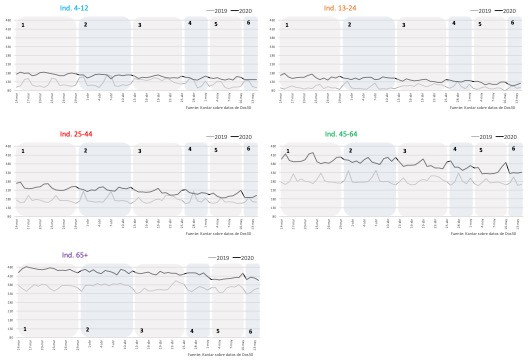Television "de-escalates" towards 2019 levels
After two months of a state of alarm, Asturias is now Spain’s leading television consumer. Consumption registered in people’s second homes reveals that large numbers have moved out of the big cities. Culture and entertainment regain ground from news programmes.
2020-05-15

Two months have passed since the declaration of the state of alarm that, to a greater or lesser extent, kept us confined to our homes. As we probably all know by now, this situation led to media consumption skyrocketing practically across the globe, mainly in the consumption of online media (browsing, messaging services, RRSS, online videos and email) and television (both linear and streaming). Our forced confinement has led to the recovery of something we thought was lost: audiences, like young people, watching linear TV again.
Mediacrest’s Analysis and Big Data department has looked carefully at this screen-watching behaviour to understand how audiences react to a situation such as the one we have been faced with, and it has reached some remarkably intriguing conclusions.
The analysis has been undertaken focusing on the markers that have defined these two months, starting with the declaration of the state of alarm on 14 March and including key stages such as the suspension of non-essential activities, the period when children and the elderly were allowed out again, and this last week, in which some provinces have entered phase 1 of the de-escalation.
In broad terms and comparing these two months of confinement (14 March - 14 May 2020) with the same period in 2019, we can highlight certain relevant findings:
An absolute record in TV consumption, both for linear and on-demand.
More than 5 hours of TV (linear and on-demand) per person per day have been consumed, 1 hour and 11 minutes more than last year (+31%)
In relative terms, it is young people who have increased their TV consumption most during the confinement (+42%), mainly in the evening slot.
The mornings is the slot that has grown most in relative terms (+53%), which is precisely the time when, under normal circumstances, most people are working and therefore not at home.
Asturias is the autonomous community that has seen the biggest increase in consumption.
Cultural programmes, thanks to documentaries; the news, especially institutional and daily; and entertainment, thanks to the magazine programmes, are the genres that have grown most in relative terms in this lockdown period, compared with in 2019 (average results for the main generalist channels: La1, T5, A3, Cuatro and LaSexta).
And although genres like fiction and game shows have declined, there are several exceptions in each of these areas. In fiction, there has been a drop in consumption across the board with the exception of mini-series, and among the game shows, viewing figures for shows that test contestants’ skills have not dropped.
It can be seen that during the confinement, audiences watched TV from their second homes, and with different viewing behaviours: previously, consumption would peak during holiday times and weekends; but now consumption has become normalised and remains constant. This means that, despite not being allowed, many people spent confinement in their second homes.
The impact on television consumption was immediate right from the start of lockdown, but what happened in each of the periods defined by the different milestones during Spain’s confinement?


Period 1 saw an unprecedented upturn in consumption reaching an all-time daily high on 15 March, the day after the announcement of the state of alarm, with an average of 6 hours viewing time per person per day, more than two hours above what was recorded on the same day in 2019. The morning slot and young people smashed previous records with 70% and 62% increases, respectively.
In period 2, marked by the milestone of the nationwide lockdown (with only essential activities still running), consumption levels did not increase with respect to the previous period, but it is the stage during which consumption remained most stable, without the fluctuations typically recorded at the weekends. The temporary change in the labour market led to an increase in the consumption of late night and early morning TV, and men and individuals aged between 45 and 65, the segment of the population that comprises the bulk of those whose activities were forcibly stopped, were those whose consumption declined least.
It was period 3, when non-essential activities were resumed, that saw one of the biggest slumps in consumption, if compared with the previous period, with the largest downturns in consumption among men and viewers between the ages of 45 and 64, as a logical consequence of the return to work. This is the phase in which the afternoon slot experienced its greatest reduction compared with the previous phase.
Period 4 was when the under 14s were first allowed to go out again, and more outdoor time meant less television, with consumption declining above all in the evening slot.
In period 5, the over 70s and sports people (or adults going for a walk and not actually practising a sport) could begin to go out. This clearly affected viewing behaviours among the elderly, who, being the target that most consumes television, was the segment that experienced the greatest decline in this phase compared with the previous one, with the evening and prime time slots falling.
Lastly, in period 6, some provinces have already gone on to phase 1 of the de-escalation. Some of the autonomous communities formed by these provinces have already registered a drop in television consumption. This is the case, mainly, for Galicia, the Balearics, Murcia, the Canary Islands, Asturias and Aragon.

In general, the daily TV consumption curve in Spain is returning to its normal values, and, before too long, it will seemingly be back to normal. Each time the weekend comes around, with the typical upturns in consumption, the decline is increasingly substantial.
THE GENRES REPOSITIONED
As regards how the different television genres have fared on the main generalist channels (La1, T5, A3, Cuatro and LaSexta) throughout the confinement phases:
Cultural programmes, entertainment and game shows have improved in viewing figures, to the detriment of news and fiction.
Specifically, within cultural programmes, there has been a notable growth in informational programmes (cooking, pets, hobbies and those that address health, wellbeing, finance, etc.). In the case of entertainment, debate shows (this includes programmes like ‘Sálvame’ on Telecinco), reality shows and comedy (which encompasses programmes like ‘El intermedio’ on La Sexta), are the genres that have most improved.
As for game shows, those that test contestants’ knowledge have remained stable (many stopped running during confinement, as was the case for ‘The Chase’ on La1, which gave way to news programmes during this period, but which has just returned to the channel’s TV schedule), and those based on skill (which includes, for example, ‘Máster Chef’ on La1) have grown.
It is clear that the milestones that have marked the confinement have found their reflection in television consumption and the specific content type consumed, clearly showing that in people’s homes, leisure time is mainly taken up with audiovisual consumption.
Following this trend, television will soon return to normal, with consumption patterns similar to last year during the same period.
If you liked it, share it
